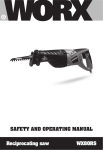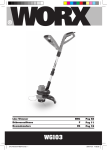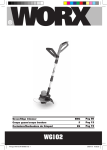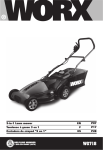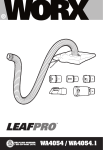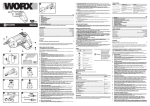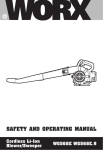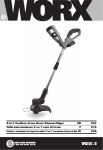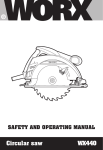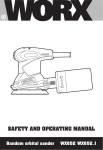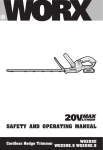Download WORX Tools WX255.1 Photo Scanner User Manual
Transcript
SAFETY AND OPERATING MANUAL WX255.1 1 10 2 9 3 4 8 7 6 5 A 2 1 2 1 C B 1 2 D1 D2 E1 E2 E3 F1 F2 G H1 H2 H3 I1 7 I2 J 1. SLIDE COVER 2. FORWARD/REVERSE ROTATION CONTROL 3. SOFT GRIP HANDLE 4. CHARGING INDICATOR 5. CHARGING SOCKET 6. ON/OFF SWITCH 7. LED LIGHT 8. SCREW HOLDER 9. CHUCK 10. BIT CARTRIDGE Not all the accessories illustrated or described are included in standard delivery. 8 TECHNICAL DATA Charger input Charger output Rated voltage Battery capacity No load speed 100-240V~50/60Hz 190mA 4.2V 4V 500mA Max* 1.5Ah lion battery 230/min Maximum torque 3N.m Machine weight 0.5kg Charger protection class Charging time /II 5 hours (Approx.) For the technical data of the types, the number of cells and the rated capacity of the batteries that can be charged, please refer the nameplate of the tool supplied by WORX. * Voltage measured without workload. Initial battery voltage reaches maximum of 4 volts. Nominal voltage is 3.6 volts. ACCESSORIES Charger1 25mm pilot hole drill bit 1 25mm screwdriver bit (PH0, PH1, PH2, PZ1, PZ2, SL4, SL5, H3, H4, H5, T10) 11 Cartridge2 Holster 1 We recommend that you purchase your accessories from the same store that sold you the tool. Use good quality accessories marked with a well-known brand name. Choose the type according to the work you intend to undertake. Refer to the accessory packaging for further details. Store personnel can assist you and offer advice. 9 GENERAL POWER TOOL SAFETY WARNINGS WARNING: Read all safety warnings and all instructions. Failure to follow the warnings and instructions may result in electric shock, fire and/or serious injury. Save all warnings and instructions for future reference. The term “power tool” in the warnings refers to your mains-operated (corded) power tool or battery-operated (cordless) power tool. 10 1. WORK AREA SAFETY a) Keep work area clean and well lit. Cluttered or dark areas invite accidents. b) Do not operate power tools in explosive atmospheres, such as in the presence of flammable liquids, gases or dust. Power tools create sparks which may ignite the dust or fumes. c) Keep children and bystanders away while operating a power tool. Distractions can cause you to lose control. 2. ELECTRICAL SAFETY a) Power tool plugs must match the outlet. Never modify the plug in any way. Do not use any adapter plugs with earthed (grounded) power tools. Unmodified plugs and matching outlets will reduce risk of electric shock. b) Avoid body contact with earthed or grounded surfaces, such as pipes, radiators, ranges and refrigerators. There is an increased risk of electric shock if your body is earthed or grounded. c) Do not expose power tools to rain or wet conditions. Water entering a power tool will increase the risk of electric shock. d) Do not abuse the cord. Never use the cord for carrying, pulling or unplugging the power tool. Keep cord away from heat, oil, sharp edges or moving parts. Damaged or entangled cords increase the risk of electric shock. e) When operating a power tool outdoors, use an extension cord suitable for outdoor use. Use of a cord suitable for outdoor use reduces the risk of electric shock. f) If operating a power tool in a damp location is unavoidable, use a residual current device (RCD) protected supply. Use of an RCD reduces the risk of electric shock. 3. PERSONAL SAFETY a) Stay alert, watch what you are doing and use common sense when operating a power tool. Do not use a power tool while you are tired or under the influence of drugs, alcohol or medication. A moment of inattention while operating power tools may result in serious personal injury. b) Use personal protective equipment. Always wear eye protection. Protective equipment such as dust mask, non-skid safety shoes, hard hat, or hearing protection used for appropriate conditions will reduce personal injuries. c) Prevent unintentional starting. Ensure the d) e) f) g) switch is in the off-position before connecting to power source and/or battery pack, picking up or carrying the tool. Carrying power tools with your finger on the switch or energising power tools that have the switch on invites accidents. Remove any adjusting key or wrench before turning the power tool on. A wrench or a key left attached to a rotating part of the power tool may result in personal injury. Do not overreach. Keep proper footing and balance at all times. This enables better control of the power tool in unexpected situations. Dress properly. Do not wear loose clothing or jewellery. Keep your hair, clothing and gloves away from moving parts. Loose clothes, jewellery or long hair can be caught in moving parts. If devices are provided for the connection of dust extraction and collection facilities, ensure these are connected and properly used. Use of dust collection can reduce dust-related hazards. 4. POWER TOOL USE AND CARE a) Do not force the power tool. Use the correct power tool for your application. The correct power tool will do the job better and safer at the rate for which it was designed. b) Do not use the power tool if the switch does not turn it on and off. Any power tool that cannot be controlled with the switch is dangerous and must be repaired. c) Disconnect the plug from the power source and/or the battery pack from the power tool d) e) f) g) before making any adjustments, changing accessories, or storing power tools. Such preventive safety measures reduce the risk of starting the power tool accidentally. Store idle power tools out of the reach of children and do not allow persons unfamiliar with the power tool or these instructions to operate the power tool. Power tools are dangerous in the hands of untrained users. Maintain power tools. Check for misalignment or binding of moving parts, breakage of parts and any other condition that may affect the power tool’s operation. If damaged, have the power tool repaired before use. Many accidents are caused by poorly maintained power tools. Keep cutting tools sharp and clean. Properly maintained cutting tools with sharp cutting edges are less likely to bind and are easier to control. Use the power tool, accessories and tool bits etc. in accordance with these instructions, taking into account the working conditions and the work to be performed. Use of the power tool for operations different from those intended could result in a hazardous situation. 5. BATTERY TOOL USE AND CARE a) Recharge only with the charger specified by the manufacturer. A charger that is suitable for one type of battery pack may create a risk of fire when used with another battery pack. b) Use power tools only with specifically designated battery packs. Use of any other 11 battery packs may create a risk of injury and fire. c) When battery pack is not in use, keep it away from other metal objects, like paper clips, coins, keys, nails, screws or other small metal objects, that can make a connection from one terminal to another. Shorting the battery terminals together may cause burns or a fire. d) Under abusive conditions, liquid may be ejected from the battery; avoid contact. If contact accidentally occurs, flush with water. If liquid contacts eyes, additionally seek medical help. Liquid ejected from the battery may cause irritation or burns. 12 6. SERVICE a) Have your power tool serviced by a qualified repair person using only identical replacement parts. This will ensure that the safety of the power tool is maintained. SCREW DRIVER AND IMPACT WRENCH SAFETY WARNING 1. Hold power tool by insulated gripping surfaces, when performing an operation where the fastener may contact hidden wiring. Fasteners contacting a “live” wire may make exposed metal parts of the power tool “live” and could give the operator an electric shock. SAFETY WARNINGS FOR BATTERY CELLS INSIDE THE TOOL a) Do not dismantle, open or shred cells. b) Do not short-circuit charging terminal. Do not store power tool haphazardly in a box or drawer where charging terminal may shortcircuit each other or be short-circuited by conductive materials. When power tool is not in use, keep it away from other metal objects, like paper clips, coins, keys, nails, screws or other small metal objects, that can make a connection from one charging terminal to another. c) Do not expose power tool to heat or fire. Avoid storage in direct sunlight. d) Do not subject power tool to mechanical shock. e) In the event of battery leaking, do not allow the liquid to come into contact with the skin or eyes. If contact has been made, wash the affected area with copious amounts of water and seek medical advice. f) Seek medical advice immediately if a cell has been swallowed. g) Keep power tool clean and dry. h) Wipe the charging terminals with a clean dry cloth if they become dirty. i) Power tool needs to be charged before use. Always refer to this instruction and use the correct charging procedure. j) Do not maintain power tool on charge when not in use. k) After extended periods of storage, it may be necessary to charge and discharge the power tool several times to obtain maximum performance. l) m) n) o) p) q) Battery gives its best performance when it is operated at normal room temperature (20°C ± 5°C). When disposing of cells, keep cells of different electrochemical systems separate from each other. Recharge only with the charger specified by WORX. Do not use any charger other than that specifically provided for use with the equipment. A charger that is suitable for one type of battery may create a risk of fire when used with another battery. Keep power tool out of the reach of children. Retain the original product literature for future reference. Dispose of properly. SAFETY WARNINGS FOR SLIDE DRIVER 1. Hold power tool by insulated gripping surfaces, when performing an operation where the fastener may contact hidden wiring. Fasteners contacting a “live” wire may make exposed metal parts of the power tool “live” and could give the operator an electric shock GENERAL SAFETY WARNINGS FOR YOUR BATTERY CHARGER - This appliance is not intended for use by persons (including children) with reduced physical, sensory or mental capabilities, or lack of experience and knowledge, unless they have been given supervision - or instruction concerning use of the appliance by a person responsible for their safety. Children should be supervised to ensure that they do not play with the appliance. ADDITIONAL SAFETY INSTRUCTIONS FOR YOUR BATTERY CHARGER 1. Before charging, read the instructions. 2. If the supply cord is damaged, it must be replaced by the manufacturer, its service agent or similarly qualified persons in order to avoid a hazard. 3. The battery terminal not connected to the chassis has to be connected first. The other connection is to be made to the chassis, remote from the battery and fuel line. The battery charger is then to be connected to the supply mains. 4. After charging, disconnect the battery charger from the supply mains. Then remove the chassis connection and then the battery connection. 5. Do not charge a leaking battery. 6. Do not use chargers for works other than those for which they are designed. 7. Before charging, ensure your charger is matching the local AC supply. 8. The charging device must be protected from moisture. 9. Do not use the charging device in the open. 10.Do not short out the contacts of battery or charger. 11. Respect the polarity “+/-“ when charging. 13 14 12.Do not open the unit and keep out of the reach of children. 13.Do not charge the batteries of other manufactures or ill-suited models. 14.Ensure that the connection between the battery charger and battery is correctly positioned and is not obstructed by foreign bodies. 15.Keep battery charger’s slots are free of foreign objects and protect against dirt and humidity. Store in a dry and frost-free place. 16.When charging batteries, ensure that the battery charger is in a well-ventilated area and away from inflammable materials. Batteries can get hot during charging. Do not overcharge any batteries. Ensure that batteries and chargers are not left unsupervised during charging. 17.Do not recharge non-rechargeable batteries, as they can overheat and break. 18.Longer life and better performance can be obtained if the battery pack is charged when the air temperature is between 18°C and 24°C. Do not charge the battery pack in air temperatures below 4.5°C, or above 40.5°C. This is important as it can prevent serious damage to the battery pack. 19.Charge only battery pack of the same model provided by WORX and of models recommended by WORX. SAFETY INSTRUCTIONS FOR BATTERY CELL a) Do not dismantle, open or shred secondary cells or battery pack. b) Do not expose cells or battery pack to heat or fire. Avoid storage in direct sunlight. c) Do not short-circuit a cell or a battery pack. Do not store cells or battery pack haphazardly in a box or drawer where they may short-circuit each other or be short-circuited by other metal objects. d) Do not remove a cell or battery from its original battery pack enclosure required for use. e) Do not subject cells or battery pack to mechanical shock. f) In the event of a cell leaking, do not allow the liquid to come in contact with the skin or eyes. If contact has been made, wash the affected area with copious amounts of water and seek medical advice. g) Do not use any charger other than that specifically provided for use with the equipment. h) Do not use any cell or battery pack which is not designed for use with the equipment. i) Do not mix cells of different manufacture, capacity, size or type within a device. j) Keep cells and battery pack out of the reach of children. k) Seek medical advice immediately if a cell or a battery pack has been swallowed. l) Always purchase the correct cell or battery for the equipment. m) Keep cells and battery pack clean and dry. n) Wipe the cell or battery pack terminals with a clean dry cloth if they become dirty. o) Secondary cells and battery pack need to be charged before use. Always use the correct charger and refer to the manufacturer’s instructions or equipment manual for proper charging instructions. Original Instructions p) Do not leave a battery pack on prolonged charge when not in use. q) After extended periods of storage, it may be necessary to charge and discharge the cells or battery pack several times to obtain maximum performance. r) Secondary cells and battery pack give their best performance when they are operated at normal room temperature (20°C ± 5°C). s) Retain the original product literature for future reference. t) Use only the cell or battery pack in the application for which it was intended. u) When possible, remove the battery pack from the equipment when not in use. v) Dispose of properly. 15 SYMBOL Do not stare directly into the tool holder. When changing the tool insert, it can be thrown out toward the front. 16 Wear protective gloves To reduce the risk of injury, user must read instruction manual Do not dispose of batteries, Return exhausted batteries to your local collection or recycling point. Warning C-tick marking Double insulation RCM marking Wear eye protection For indoor use only Wear ear protection Fuse T 1A time lag fuse with rated current of 1A Wear dust mask The output plug is with positive center pole and negative outer pole Do not burn Don’t use double end bit Do not expose to rain or water ABN: Australian Business Number, according to which business details such as business name and address can be found at website http://abr.business.gov.au OPERATING INSTRUCTIONS NOTE: Before using the tool, read the instruction book carefully. INTENDED USE The power tool is intended for driving in and loosening screws as well as for drilling in wood, metal and plastic. ACTION FIGURE Before operation Charging the Battery NOTE: 1. Maximize Battery Performance Prior to initial use, the battery must be charged 5 hours to fully utilize the battery capacity. 2. When the battery is full charged, the light turns green. See Fig. A Operation Selecting a Bit See Fig. F1,F2 Drilling a Pilot Hole See Fig. G Assembling screw See Fig. H1,H2,H3 Tightening and Loosening Screw See Fig. I1,I2 Operating the On/Off Switch WARNING: Do not operate for long periods at low speed because excess heat will be produced internally. See Fig. J LED Light Indicator See Fig. J Automatic Spindle Locking NOTE: When the slide driver is out of power, this function enables the customer tightening or loosening screws manually. Assembly and adjustment Inserting and Removing the Bit Cartridge See Fig. B,C Assembling and Removing the Screw Holder See Fig. D1,D2 Forward/reverse/lock WARNING: Never change the direction of rotation when the chuck is rotating, wait until it is stopped! See Fig. E1,E2,E2 MAINTENANCE Your power tool requires no additional lubrication or maintenance. There is no user serviceable parts in your power tool. Never use water or chemical cleaners to clean your power tool. Wipe clean with a dry cloth. Always store your power tool in a dry place. Keep the motor ventilation slots clean. Keep all working controls free of dust. If you see some sparks flashing in the ventilation slots, this is normal and will not damage your power tool. 17 TROUBLE SHOOTING 18 Problem Possible cause Solution Battery will not charge 1. Charger not plugged into a working outlet. 2. Surrounding air temperature is too hot or too cold. 1. Plug charger into a working outlet. Check current by plugging in a lamp. 2. Move charger to an appropriate place which temperature is suitable for the charger. Switch cannot be pressed Forward/Reverse switch at middle position Make sure switch is on Forward or Reverse rotation according to project need. Driver stops during driving screws Driver battery is out of power Make sure the driver is fully charged before using it. Bit Cartridge will not rotate when Cover slides. The cover is not fully open Make sure the Cover is fully open and past the red line on the tool. www.worx.com Copyright © 2014, Positec. All Rights Reserved. 2CSD24APK11000A0




















